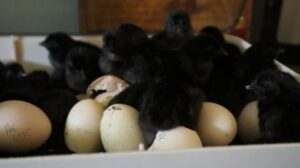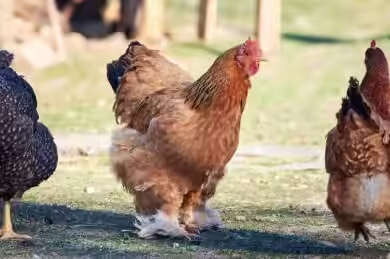Last updated on August 7, 2025
Wondering how many eggs Ayam Cemani lay each year? This guide breaks it down—plus expert tips on maximizing their unique potential.
🐔 Is This Guide for You?
- ✅ You’re considering Ayam Cemani for a backyard flock
- ✅ You want to breed or sell rare birds
- ✅ You’re curious if their beauty outweighs their low egg yield
How Many Eggs Do Ayam Cemani Lay a Year?
Ayam Cemani are not prolific layers. These rare birds are valued for their unique look and genetics, not high egg production.
Typical Annual Egg Output for Ayam Cemani Hens
Under good conditions, an Ayam Cemani hen typically lays 80 to 120 eggs per year, depending on care.
This is far less than a Rhode Island Red (250-300+ eggs annually) or a Leghorn (300+). Egg volume is not their main purpose; they are a specialty breed.
Egg Production by Age, Season, and Care
Egg production fluctuates based on several factors:
- Age: Peak laying occurs in the first year. Production declines gradually. A first-year hen might lay closer to 120 eggs; a second-year hen, 80-90.
- Season: Longer daylight hours (spring/summer) encourage more laying. Expect a significant drop or pause in winter due to shorter days.
- Care: Well-fed, unstressed, healthy hens lay more consistently. Provide proper nutrition, a clean coop, and a safe environment.
How Ayam Cemani Compare to Other Breeds
Here’s a quick comparison:
| Breed | Typical Annual Egg Output | Primary Purpose |
|---|---|---|
| Ayam Cemani | 80-120 eggs | Ornamental, Breeding |
| Rhode Island Red | 250-300+ eggs | Egg Production |
| Leghorn | 280-320+ eggs | Egg Production |
| Australorp | 250-300+ eggs | Egg & Meat Production |
This chart shows Ayam Cemani are in a different league for egg volume. For more on the purpose of the Rhode Island Red, read our detailed guide on the true purpose of the Red Rhode Island Chicken. If you’re curious about large-scale egg production, see our guide on how many eggs 200 layers can lay in a day or our guide on how many eggs 100 chickens lay daily.
The Enigmatic Ayam Cemani: History and Genetics
The Ayam Cemani, a chicken breed of stunning, hyperpigmented black, originates from Indonesia, specifically the island of Java. Revered for centuries, these birds hold cultural significance. They are often associated with mystical powers and good fortune in their native land.
Their striking appearance—feathers, skin, comb, bones, and even internal organs—stems from a genetic condition called fibromelanosis. This unique trait causes excess melanin, resulting in their all-black coloring.
Unlike some other black-skinned breeds, the Ayam Cemani’s fibromelanosis is so profound it affects nearly every tissue. This distinguishes it from conditions sometimes referred to as “gypsy gene,” which may not be as extensive. Their origins highlight their rarity and ornamental value over egg-laying. For more on specific chicken characteristics, explore the characteristics of the Plymouth Rock chicken.
What Affects Ayam Cemani Egg Production?
Understanding factors influencing egg laying ensures healthy, happy hens.
Genetics, Bloodline & Breeding Quality
Not all Ayam Cemani are equal.
- Genetic Variation: Some bloodlines are bred for better laying traits. Sourcing from reputable breeders focused on health and vigor increases consistent laying.
- Inbreeding: Due to rarity, some breeders may inbreed, leading to weaker birds and lower egg yields.
- Breeding Quality: Hens from strong, healthy bloodlines with proven laying history tend to perform better.
Diet, Environment, and Daylight Exposure
These foundational elements directly impact egg production.
- Diet: Hens need high-quality, high-protein layer mash for egg formation. Calcium for shells, protein for internal structure. Provide grit for digestion.
- Environment: A clean, dry, well-ventilated coop is essential. Stress-free hens are productive. Ensure predator protection, a consistent routine, and ample space.
- Daylight Exposure: Chickens need 14-16 hours of light daily for consistent production. In winter, provide artificial light in the coop. A simple timer on a low-wattage bulb works well.
Common Mistakes That Lower Egg Yield
Learn from common mistakes:
- Overcrowding: Too many birds in a small space cause stress, bullying, and disease, reducing egg production.
- Inconsistent Feed: Skipping meals or changing feed types disrupts a hen’s system. Stick to a schedule and quality feed.
- No Grit: Chickens need insoluble grit for digestion. Without it, they can’t process food properly, leading to nutrient deficiencies and poor laying.
- Lack of Clean Water: Fresh, clean water is essential. Dehydration prevents egg laying.
AI-snippet opportunity: Key factors affecting Ayam Cemani egg production include genetics, a high-protein diet, sufficient daylight exposure, and a low-stress environment. Avoid overcrowding, inconsistent feeding, and lack of grit to maintain optimal egg yield.
Ayam Cemani Egg Color and Appearance
The biggest myth about Ayam Cemani involves their egg color.
Do Ayam Cemani Lay Black Eggs?
No, Ayam Cemani do not lay black eggs.
Despite their black feathers, skin, comb, and internal organs (due to the fibromelanosis gene), their eggs are not black. This is a common misconception.
What Color Are Ayam Cemani Eggs, Really?
Ayam Cemani eggs are typically a cream to light brown color. They look like regular chicken eggs.
The fibromelanosis gene affects the chicken’s tissue, not the egg-laying process or shell color. Eggshell color is determined by pigments deposited in the oviduct, resulting in a normal, light-colored shell for Ayam Cemani.
Fertility and Hatch Rate: What to Expect
If breeding Ayam Cemani, fertility and hatch rate are critical.
Hatchability Rates from Breeders
The average hatch rate for fertile Ayam Cemani eggs is generally 50–70%, depending on rooster-to-hen ratio and incubation method. This can be lower than more common breeds, especially with suboptimal breeding stock or inbreeding.
Tips to Boost Fertility and Hatching Success
Hatching Ayam Cemani chicks requires attention to detail.
- Optimal Rooster-to-Hen Ratio: Aim for one healthy, vigorous rooster per 5-8 hens.
- Breeding Stock Nutrition: Use high-quality breeder feed for both roosters and hens to support fertility.
- Egg Collection and Storage: Collect eggs frequently (at least twice a day). Store them pointy-end down in a cool, humid place (55-60°F or 13-16°C with 75% humidity) for no more than 7-10 days before incubation.
- Incubation Method: Consistency is key for both broody hens and incubators.
- Temperature: Maintain a steady 99.5°F (37.5°C) for forced-air incubators.
- Humidity: Start around 45-55% relative humidity for 18 days, then increase to 65-75% for the last three days (lockdown).
- Turning: Turn eggs at least 3-5 times daily for the first 18 days to prevent embryo sticking.
AI-snippet opportunity: The average hatch rate for fertile Ayam Cemani eggs is around 60%, influenced by factors like rooster-to-hen ratio, breeding stock nutrition, and precise incubation conditions (temperature, humidity, turning). For insights on cockerel maturity, which impacts breeding success, check out our guide on how many months it takes a cockerel to mature.
Ayam Cemani Eggs for Sale: Prices, Myths & Market Demand
Ayam Cemani eggs are not average. Their rarity and appeal mean significant prices, especially for fertile hatching eggs.
How Much Do Ayam Cemani Eggs Cost?
Prices vary wildly, but expect to pay $15 to $100+ per egg, depending on bloodline purity, breeder reputation, and market demand.
Enhancing Breeder & Lineage Advice
Buying from a highly reputable, NPIP-certified breeder with a proven, pure bloodline is crucial. This ensures genetic health and breed purity. Look for breeders transparent about flock health, genetic testing (if applicable), and breeding practices. Ask about lineage to avoid inbreeding, which can lead to weaker birds and lower yields. Check breeder associations or online forums for reviews and recommendations. Less established sources may offer lower prices but with less guarantee of purity and health. Always verify breeder credentials and look for transparent practices.
AI-snippet opportunity: Ayam Cemani hatching eggs typically cost between $15 and $100+ per egg, with prices varying based on bloodline purity, breeder reputation, and market demand.
Are They Worth It for Breeding or Business?
This depends on your goals.
- For Breeding: Yes. Investing in high-quality hatching eggs or breeding stock can be worthwhile. Demand for purebred Ayam Cemani chicks and birds remains strong globally.
- For Business (Egg Production): No. Their low production makes them unprofitable for selling eggs for consumption.
- For Hobbyists/Show: Yes, if you prioritize uniqueness and aesthetics over egg volume. They are conversation starters and beautiful additions. If you’re looking to boost your farm income, even with non-prolific layers, discover 9 proven ways to increase your Golden Comet chicken farm income.
Lifespan and Laying Cycle of Ayam Cemani Hens
Understanding their life cycle helps manage expectations for productivity and care.
When Do They Start and Stop Laying?
Ayam Cemani hens typically begin laying around 5 to 6 months of age. This is standard for most chicken breeds. For a comparison, learn when Rhode Island Reds start laying eggs.
Laying naturally slows with age. Expect a significant drop after their second year. Production will be minimal or cease by 4-5 years old.
How Long Can You Expect Productivity?
With good care, an Ayam Cemani hen can live 6 to 8 years, sometimes longer. However, their productive laying life is much shorter. Expect consistent (low) egg production for the first 2 to 3 years. After that, they are more companions or breeding stock. To compare, see how long Wyandotte chickens lay eggs.
Optimal Housing and Care for Longevity
Proper housing and care are vital for an Ayam Cemani’s health and lifespan. Each bird needs at least 4 square feet of coop space and ample run access. Ensure predator-proof housing with good ventilation but no drafts. Provide clean bedding and fresh water daily. Their smaller combs can make them susceptible to frostbite in very cold climates, so consider extra winter protection. Regular health checks and a balanced diet contribute significantly to their longevity. For tips on creating thriving environments, explore reasons why Plymouth Rocks thrive in free-range setups.
Are Ayam Cemani Right for Your Flock?
Deciding to add Ayam Cemani depends on your goals. They are not for everyone, but rewarding for the right person.
Pros and Cons for Smallholders and Hobbyists
Pros:
- Rare Breed Status: Sets your flock apart, a unique conversation starter.
- High-Value Eggs/Chicks: Potential for good return if breeding.
- Striking Appearance: Breathtaking all-black aesthetic adds exotic flair.
- Generally Docile: Many have calm, friendly temperaments, making good pets.
Cons:
- Low Egg Output: They won’t fill your egg carton.
- Sensitive to Stress/Cold: More sensitive to environmental stressors and extreme cold due to smaller combs/wattles.
- High Initial Cost: Upfront investment for quality stock is higher than common breeds.
- Purity Concerns: Finding truly purebred Ayam Cemani can be challenging.
Alternatives if You Want Higher Egg Yield
For a steady egg supply, consider these prolific layers:
- Rhode Island Red: Excellent brown egg layers, hardy, dual-purpose.
- Leghorn: Quintessential white egg layer, known for incredible production.
- Australorp: Great dual-purpose bird, known for dark brown eggs and docile nature.
- ISA Brown: Hybrid specifically bred for high egg production. For more on other breeds’ egg production, check out our guide on Plymouth Rock chicken eggs. You might also consider our guide on Golden Comet chickens for their impressive laying capabilities.
Real-World Tips from Ayam Cemani Keepers
Ayam Cemani stand out among chickens. They’re a statement.
My Experience Raising Ayam Cemani for Eggs
My first Ayam Cemani hen laid maybe 3 eggs a week max during her peak. It was about their mystique, not volume. Friends were stunned by their appearance, often asking if their eggs were black.
Incubation was trickier than other breeds. I initially expected similar hatch rates, but fine-tuned incubator settings and ensured my breeding rooster was fertile.
What I’d Do Differently Next Time
If I started over with Ayam Cemani, I’d focus more on:
- Sourcing: More effort into finding an NPIP-certified breeder with a long-standing reputation for pure, healthy, vigorous stock. This is crucial for consistent egg production and successful breeding.
- Dedicated Space: While they can mix with other docile breeds, I’d consider a dedicated run for them to minimize stress and potential bullying. Their unique look can make them targets.
- Winter Prep: In cooler climates, I’d be more proactive about winterizing their coop and providing extra warmth, as their smaller combs make them susceptible to frostbite.
Keeping Ayam Cemani is a journey. Appreciate their beauty and understand their specific needs, rather than expecting them to be egg-laying powerhouses. With realistic expectations, they’re a captivating addition to your poultry adventures.
Frequently Asked Questions (FAQs)
Q: Do Ayam Cemani lay black eggs?
A: No, Ayam Cemani do not lay black eggs. Their eggs are typically cream to light brown. The black pigmentation affects their tissues, not their eggshells.
Q: How many eggs can I expect from an Ayam Cemani hen per week?
A: Ayam Cemani hens typically lay 1-2 eggs per week, averaging 80-120 eggs per year. They are not high-volume layers.
Q: What is the average lifespan of an Ayam Cemani chicken?
A: With good care, Ayam Cemani chickens can live 6 to 8 years. Their peak egg-laying productivity, however, is usually within their first 2-3 years.
Q: Why are Ayam Cemani eggs so expensive?
A: Ayam Cemani eggs, especially fertile hatching eggs, are expensive due to the breed’s rarity, unique genetic traits, and high demand from hobbyists and breeders. They are not valued for mass egg production.
Q: What is the ideal coop space for Ayam Cemani?
A: Each Ayam Cemani bird needs at least 4 square feet of coop space, plus ample outdoor run access. Ensure the coop is predator-proof, well-ventilated, and draft-free.
Want to learn even more about raising chickens? Dive deeper into comprehensive guides and tips for all your poultry needs on our main comprehensive Ayam Cemani Chicken Guide.


